Similar presentations:
Ancient Egyptian Architecture. Lecture 2
1. Ancient Egyptian Architecture
ANCIENT EGYPTIANARCHITECTURE
LECTURE 2
2. Module Outline
MODULE OUTLINE• Historical Background
• Location and period
• Social characteristics and beliefs
• Architecture of the Civilization
Early Kingdom Tombs
Middle and New Kingdom Burial Chambers
3. Learning Outcomes
LEARNING OUTCOMES• The influence of geographical location on social
life and architecture
• Architecture as a store of social history –
Architecture of pyramids, tombs and temples –
Evolution of architectural elements of column,
beam, obelisk, wall relief and clerestory lighting
• Architectural principles emphasizing mass rather
than space and linearity and axiality as organizing
principles
4. Location
LOCATION• Located in Africa on the
northern edge of the
Sahara
• The Nile bisects through the
land from the south to the
north
• The Nile is a seasonal river
that overflows its bank
yearly to create a fertile
valley
• The Ancient Egyptians lived
in the fertile valley and
grew their crops
• They buried their dead in
the desert
5. Period
PERIOD• The history of ancient Egypt is divided into periods
based on ruling dynasties
• Seven periods can be identified;
• 4500 to 2000 BC Early Dynastic
• 2350 – 2200 BC
Old Kingdom
• 2000- 1600 BC
First Intermediate period
• 1600 – 1717 BC
Middle Kingdom
• 1350 – 612 BC
Second Intermediate Period
• 612 – 539 BC
New Kingdom
• 539 – 330 BC
Greek-Roman Period
6. Architectural Ideas
ARCHITECTURAL IDEAS– Ancient Egyptians viewed earthly dwellings
as temporary
– They paid little attention to house
construction
– The tomb was seen as a permanent
dwelling for the afterlife
– Tremendous effort was exerted in tomb
construction
– The mummified dead body was buried in a
stone box called sarcophagus in the tomb
7. Architectural Ideas
ARCHITECTURAL IDEAS• They believed that
a dead person
needs all his worldly
goods
• The tomb was
usually packed with
all the treasures of a
dead person
• If anything cannot
be provided, it is
painted on the walls
of the tomb
8. necropolis
NECROPOLIS• Tombs also have
charms to protect
the dead person &
his property
• The dead were
buried in cities of
the dead, called
Necropolis located
in the desert
9. Burial architecture
BURIAL ARCHITECTURE• Tombs were most outstanding architectural element
of the period
• Tombs also serve as the focus for the worship of the
dead
• a bench-like structure over graves to create first
burial structure is called Mastaba
• The Tomb evolved during the old kingdom from the
Mastaba, through the stepped pyramid to the
renown ancient Egyptian pyramid
• Above ground the Mastaba is a large bench of
sun-baked bricks rising 9 meters high
10. Mastaba
MASTABA• Internally, a Mastaba
consist of three parts- a
burial chamber, a
Serdab and a chapel
• The burial chamber
was located 1m below
ground
• It was connected to
burial chamber above
ground through a shaft
• The burial chamber is
the place for the burial
of the dead person
11. Mastaba
MASTABA• The Serdab and
Chapel are located
above ground
• The serdab is a room
where the statue of
the dead person is
kept
• The statue acts as a
substitute for body in
case it is destroyed
• Mastaba served as
an embryo for the
evolution of the
pyramid
12. Stepped Pyramid
STEPPED PYRAMID• King Zoser was the powerful pharaoh of the third
dynasty of the old kingdom
• The stepped pyramid was built for king Zoser by
Imhotep
• It was built as a funeral complex in the necropolis at
Saqqara
• Imhotep initially conceived of the tomb as a large
Mastaba of stone
13. Stepped Pyramid
STEPPED PYRAMID• Dissatisfaction with the
result led to the
stacking of mastaba
one on top of another
• The result was the
stepped pyramid with
five sloping setbacks
• The stepped pyramid is
the intermediate step
between mastaba and
geometric pyramid
14. Stepped Pyramid
STEPPED PYRAMID• Stepped pyramid was
200 feet high with 6 giant
steps
• The burial chamber is
entered from the north
side and is 92 feet down
• On either side of the
chamber are store rooms
for the kings treasures
• All the treasures buried
with Zoser have long
been stolen
• A stone statue of Zoser
was also recently found
staring out through peep
holes in his Serdab
15. Stepped Pyramid
STEPPED PYRAMID• The funeral complex consisted of palaces,
temples and the stepped pyramid
• They were all surrounded by a fence wall 33
feet high
16. Stepped Pyramid: fence wall
STEPPED PYRAMID: FENCE WALL• The false doors were for the use of the
pharaoh’s ka (soul)
17. Stepped Pyramid
STEPPED PYRAMID• The entrance door
leads to a long hall
having two rows of
columns
• This is one of the first
uses of columns in
history
• The columns were
designed to look
like bundles of reeds
and had flutes
18. Stepped Pyramid
STEPPED PYRAMID• In the north palace is
also found stone columns
with capitals
• They were designed to
look like the papyrus
plant
• Zosers funeral complex
was designed as a
model of his palace, city
and kingdom
• The shape of the
pyramid suggest a
stairway to the sky to join
the sun God Amon Ra
19. Attempts at Pyramid Building
ATTEMPTS AT PYRAMID BUILDING• King Huni made the first
attempt at building a
pure pyramid at
Medun
• He constructed a
seven stepped
pyramid with a square
plan and height of 90
meters and an angle
of incline of 51 degrees
• The pyramid did not
have a mortuary
temple
20. Attempts at Pyramid Building
ATTEMPTS AT PYRAMID BUILDING• Pharaoh Snefru made
two attempts at
pyramid construction
• His first pyramid, the
Bent pyramid at
Dashur had a square
plan with a height of
102 meters
• The pyramid had a
change of angle
midway leading to its
being called the bent
pyramid
21. Attempts at Pyramid Building
ATTEMPTS AT PYRAMID BUILDING• Snefru’s second
pyramid, the north
pyramid, is the place
he was buried
• It had a low pitch of
43 degrees instead of
52 degrees making it
look stunted
• A true pyramid has
an incline angle of 52
degrees
22. The Pyramids at Giza
THE PYRAMIDS AT GIZA• The construction of a
true geometrical
pyramid was achieved
during the reign of
Cheops, son of Snefru
• This was located at Giza
• This pyramid is called the
• Great Pyramid because
of its size
• The pyramid is 482 ft high
on a plan 760 ft square
23. The Pyramids at Giza
THE PYRAMIDS AT GIZA• Two additional
pyramids were
subsequently built at
Giza
• The second largest in
the center was built by
Chefren, the son of
Cheops
• The third and smallest
was built by Mykerinus,
the son of Chefren
• The three together are
referred to as the
pyramids at Giza
24. The Pyramids at Giza
THE PYRAMIDS AT GIZA• The three are
aligned diagonally
along the
projection of the
diagonal of the
great pyramid
• The small pyramids
close to them were
built for their
Queens
25. The Great Pyramid of Cheops
THE GREAT PYRAMID OF CHEOPS• The great pyramid has
a unique internal
arrangement
• First it has a chamber
built below the base of
the pyramid
• Another chamber was
built above it known as
the queen’s chamber
• A larger burial
chamber known as the
king’s chamber was
built at the center of
the pyramid
26.
• The pyramids were designed as part of a funeralcomplex for the burial of a pharaoh
• Chefren’s complex is the best preserved
example
• The complex consist of three interconnected
units:
27.
• A valley temple by the river Nile where thepharaoh’s body was embalmed
• A pyramid mortuary temple for rituals
• A long narrow causeway connecting the two
28.
• This temple had many small chapels each with falsedoors
• Many statues of the pharaoh were place in the
temple so that his ka could come back each night
• After prayers to the God Osiris, the body was
lowered through the secret opening on the north
side to his burial chamber
• There he was laid in his stone Sarcophagus
29. The Sphinx at Giza
THE SPHINX AT GIZA• Located in Giza is the
great Sphinx with the
body of a lion and
head of Chefren
• The reason for its
construction is not clear
• A theory hold that it
was produced from
leftover material
• It may also have been
carved to stand guard
over the temple and
tomb of Chefren
30. Mid & New Kingdom Burial-Cham
MID & NEW KINGDOM BURIAL-CHAM• The Middle Kingdom began
when pharaoh Mentuhotep
united Egypt again after the
first intermediate period
• During the middle kingdom,
the practice of pyramid
construction disappeared
• Focus in architectural
development was however
still on tombs and burial
chambers
• Two categories of structures
came into use- mortuary
temples and underground
tombs
31. Mortuary Temple of Mentuhotep
MORTUARY TEMPLE OF MENTUHOTEP• Two mortuary
temples were built at
Del al Bahari;
mortuary temple of
Mentuhotep and
Hatshepsut
• Mentuhotep was the
first Pharaoh of the
middle kingdom
• He built the first
mortuary temple at
Del-al Bahari
32. Mortuary Temple of Mentuhotep
MORTUARY TEMPLE OF MENTUHOTEP• Entrance to the real
tomb is found at the rear
from the western
courtyard
• The burial tomb is
accessible through a
ramp leading down at
the center of the court
yard
• Just like the pyramid
funeral complexes, the
temple of Mentuhotep
also has a causeway
leading to a valley
temple
33. Mortuary Temple of Hatshepsut
MORTUARY TEMPLE OF HATSHEPSUT• The temple of
Mentuhotep served as
a model in the design
of her temple
• Her extraordinary
funeral temple located
at Del-Al-Bahari, is set
against the
background of the cliffs
• The architect of her
temple is believed to
be Senmut who is also
buried in the temple
34. Mortuary Temple of Hatshepsut
MORTUARY TEMPLE OF HATSHEPSUT• The temple of Hatshepsut
is like a giant stage on
three levels
• Each of the three levels
was connected by a ramp
• On the top level is her
chapel dedicated to the
goddess Hathor
• The chapel was dug out of
the rock cliff
• Her temple captures the
shift from the compact
geometry of the old
kingdom pyramids to the
linear composition of the
New Kingdom temples
35. Underground Tomb- Rock Cut Tomb
UNDERGROUND TOMB- ROCK CUTTOMB
• Two types of
Underground tombs were
built by pharaohs and
nobles during the Middle
and New Kingdom
periods- Rock cut tombs
and Shaft tombs
• Rock cut tombs are
tombs that are carved
out of rocks
• Many of theses are found
along the cliff of the Nile
• A very good example is
the Rock cut tomb at
Beni Hassan
36. Underground Tomb- Rock Cut Tomb
UNDERGROUND TOMB- ROCK CUTTOMB
• Beni Hassan consist of 3
elements:
• A colonnade entrance
portico for public
worship
• Behind the portico, a
chamber or hall with
columns supporting the
roof serving as a
chapel
• A small recess towards
the back of the chapel
where the person is
buried
37. Underground Tomb- Rock Cut Tomb
UNDERGROUND TOMB- ROCK CUTTOMB
• The columns on the
exterior were
shaped like a prism
with 8 or 16 sides
• The columns in the
interior were
designed as a
bundle of reed tied
together by rope
38. Underground Tomb- Shaft Tombs
UNDERGROUND TOMB- SHAFT TOMBS• Shaft tombs were a
complex series of
underground corridors
and rooms cut out of
the mountains in the
valley of the King at
Del-Al-Bahari
• The large number of
rooms and their
complicated
arrangement is
deliberately done to
create a maze or
puzzle
39.
EnglishKazakh
Russian
1
Pylon
Пилон
Пилон
The wide entrance gateway of an Egyptian temple, characterized by sloping walls
2
Mastaba
Мастаба
Мастаба
A bench-like structure over graves
3
Serdab
Сердаб
Сердаб
A burial chamber of mastaba
4
Imhotep
Имхотеп
Имхотеп
The priest for Zoser, founder of Egyptian medicine, first recorded architect in
history, an Astromoner
5
Senmut
Сенмут
Сенмут
The architect of Queen Hatshepsut ‘s mortuary temple
6
Clerestory
Windows were place to allow light to enter, in between the two roofs
7
Hypostyle
Гипостиль
Гипостиль
Multi-columned hall
8
Egyptian hall
Мысыр ханасы
Египетский зал
A hall with an internal perystyle (in West Europe architecture)





























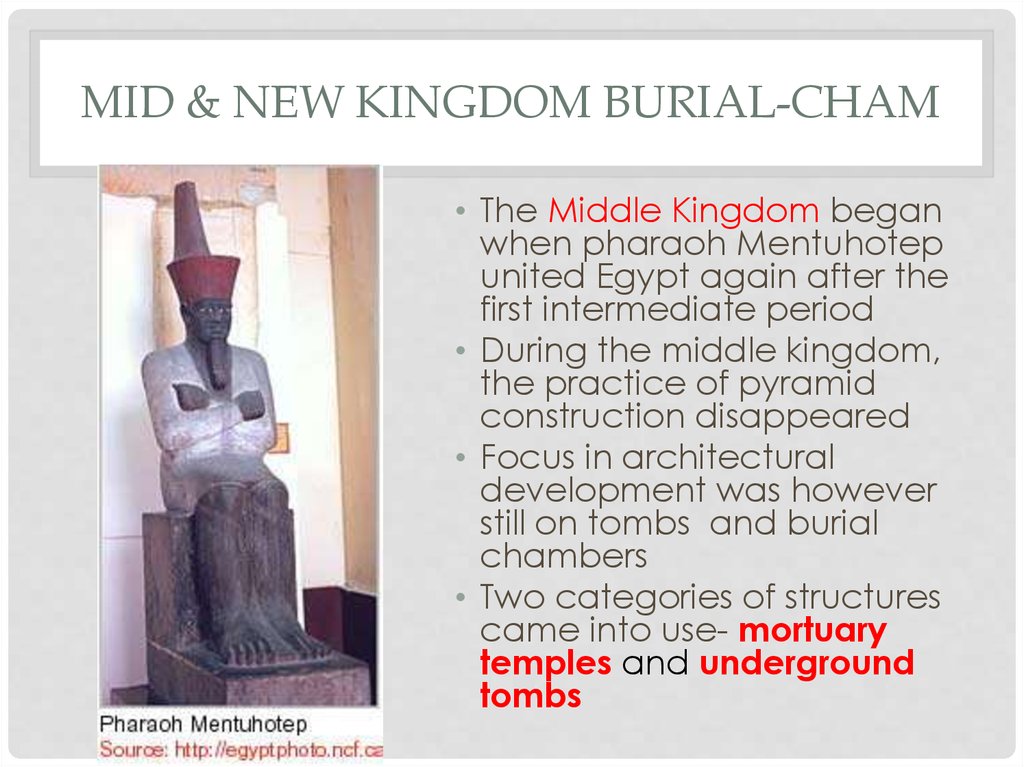
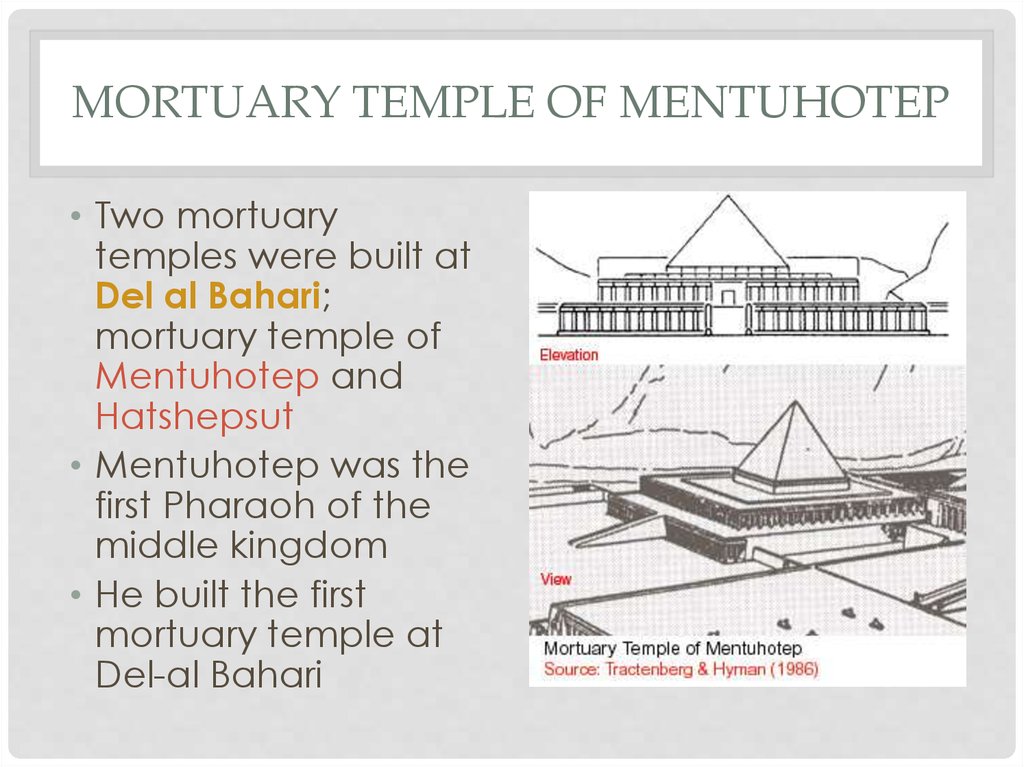

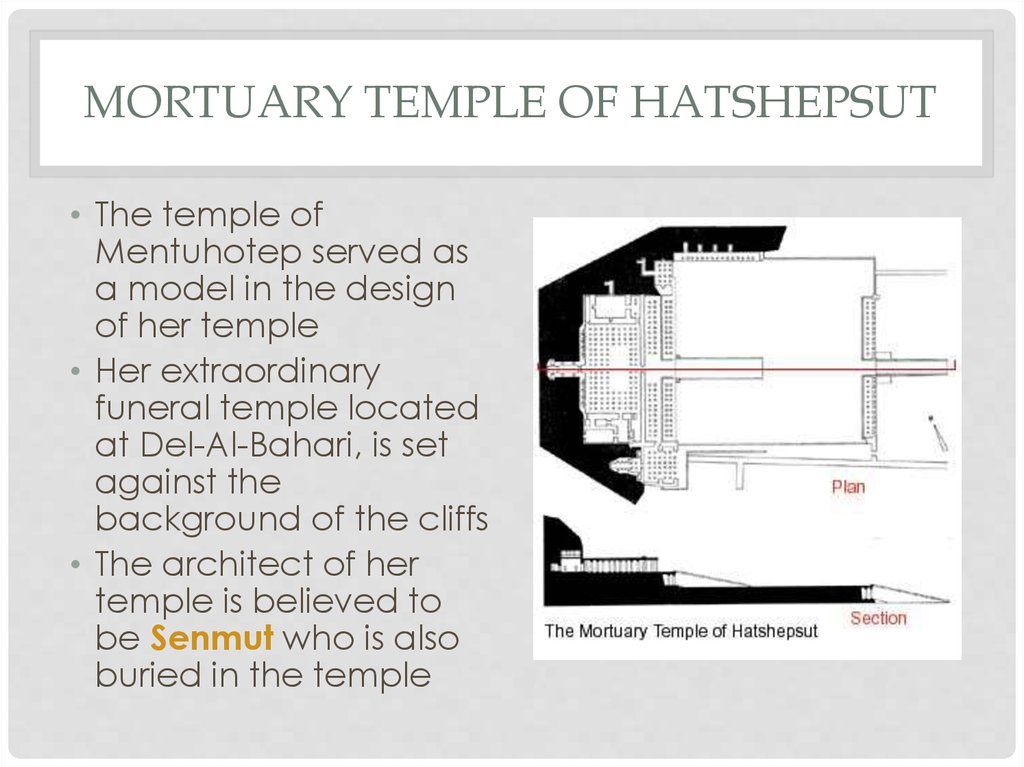

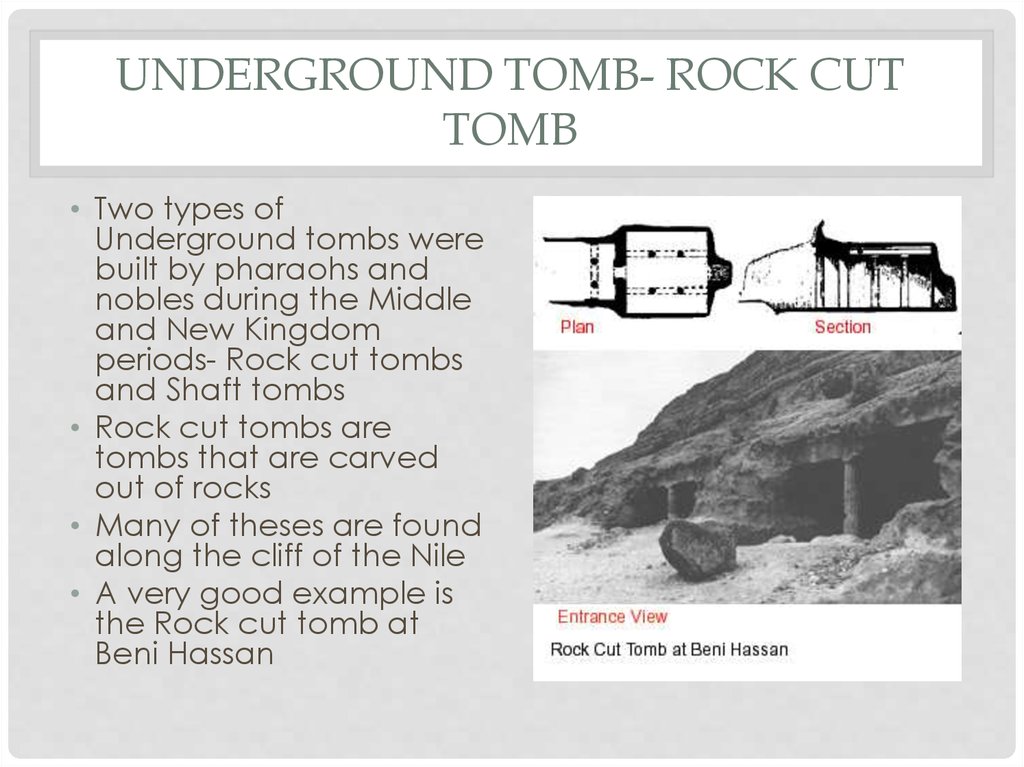
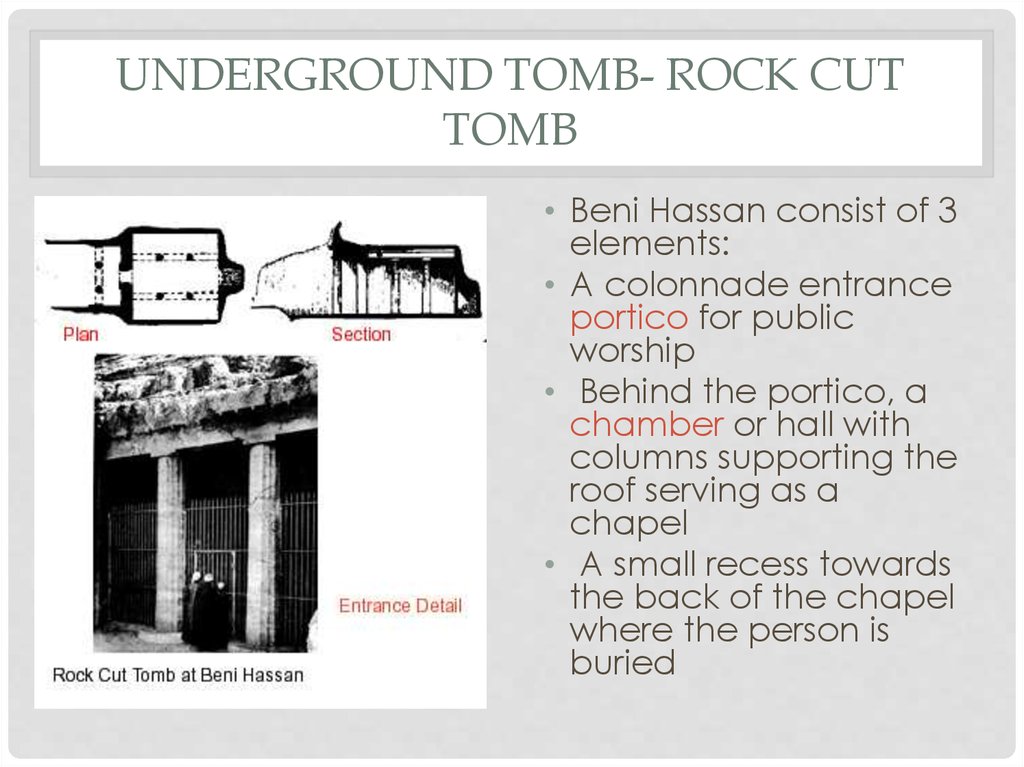



 history
history art
art








